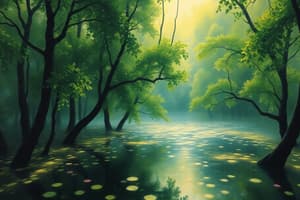Podcast
Questions and Answers
What is the primary role of producers in an ecosystem?
What is the primary role of producers in an ecosystem?
- They make their own food using sunlight. (correct)
- They decompose dead organisms.
- They consume other organisms for energy.
- They are always herbivores.
Primary consumers in an ecosystem only eat other animals.
Primary consumers in an ecosystem only eat other animals.
False (B)
What are the organisms that break down dead bodies into small parts called?
What are the organisms that break down dead bodies into small parts called?
Decomposers
The process of breaking down complex dead bodies is known as ______.
The process of breaking down complex dead bodies is known as ______.
Match the following types of consumers with their feeding habits:
Match the following types of consumers with their feeding habits:
What is the primary source of energy for the ecosystem?
What is the primary source of energy for the ecosystem?
Hawks eat plants as a primary source of energy.
Hawks eat plants as a primary source of energy.
What process do plants use to make their own food?
What process do plants use to make their own food?
Plants absorb sunlight to make their own food and to gain ______.
Plants absorb sunlight to make their own food and to gain ______.
Match the following animals with what they primarily eat:
Match the following animals with what they primarily eat:
Flashcards are hidden until you start studying
Study Notes
Ecosystem Overview
- Ecosystem consists of living organisms and nonliving things.
- Nonliving components include water, soil, temperature, minerals, air, and sunlight.
- Living organisms depend on and interact with these nonliving elements for survival.
Energy Flow in Ecosystems
- Energy flows from plants to animals and between animals through consumption.
- Upon death, energy returns to the soil, maintaining ecological balance.
- The sun is the primary energy source for ecosystems.
Plant Interaction
- Plants utilize sunlight, water, soil, air, and minerals to perform photosynthesis and produce food.
- Photosynthesis converts sunlight into glucose, an energy-rich substance.
Hawk Ecosystem Role
- Hawks are carnivorous and prey on small animals like snakes and mice, indirectly relying on plants for energy.
- Energy transfer can occur through multiple trophic levels, such as:
- Plants to primary consumers (herbivores).
- Primary consumers to secondary consumers (carnivores).
- Energy returns to soil post-mortem.
Feeding Relationships
- Animals cannot create their food and thus depend on other organisms for energy.
- Energy requirements vary: higher for activities like exercise, lower for rest or thinking.
Types of Organisms by Feeding
- Producers (Plants)
- Utilize sunlight to synthesize food (glucose).
- Cannot consume other organisms.
- Consumers (Animals)
- Organisms that feed on plants or other animals.
- Categorized into:
- Primary Consumers (herbivores): Directly consume plants.
- Secondary Consumers: Predators consuming primary consumers.
- Tertiary Consumers: Top of the food chain, often preying on secondary consumers.
- Decomposers (Fungi and Bacteria)
- Break down dead matter into nutrients.
- Important for returning nutrients to the soil, enhancing fertility, and facilitating new plant growth.
Decomposition Process
- Decomposition involves tiny organisms that convert complex bodies into simpler nutrients.
- Resulting nutrients enrich the soil, promoting the growth of new plants.
Conclusion
- Ecosystems offer food, water, and shelter for organisms.
- Understanding energy flow and the roles of different organisms is crucial for ecosystem health and sustainability.
Studying That Suits You
Use AI to generate personalized quizzes and flashcards to suit your learning preferences.




